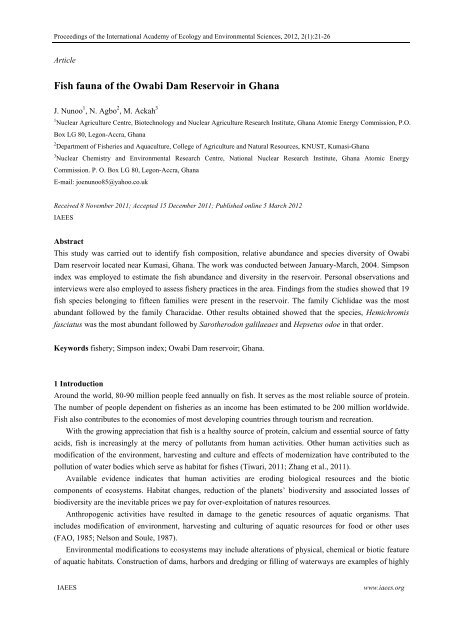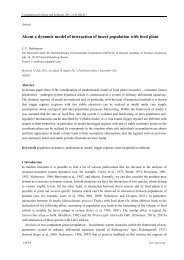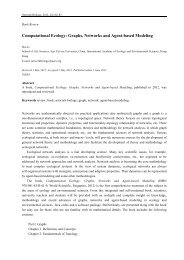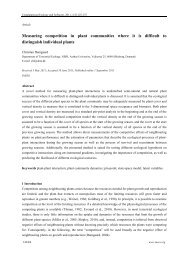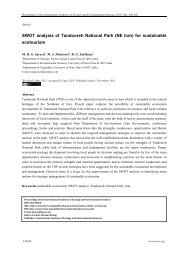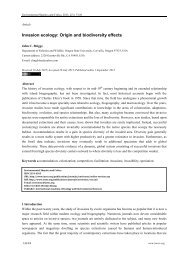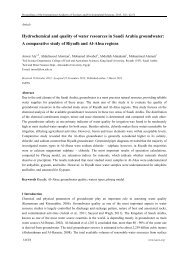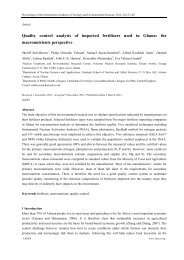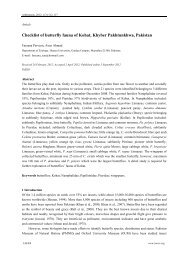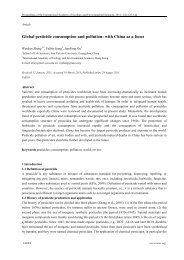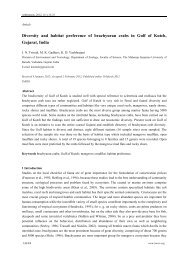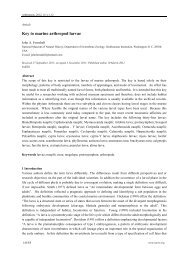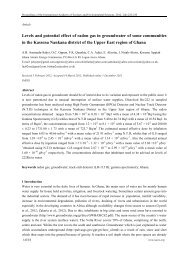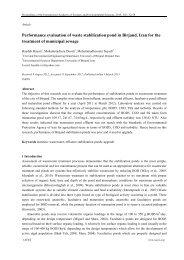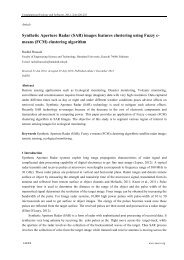Fish fauna of the Owabi Dam Reservoir in Ghana - International ...
Fish fauna of the Owabi Dam Reservoir in Ghana - International ...
Fish fauna of the Owabi Dam Reservoir in Ghana - International ...
Create successful ePaper yourself
Turn your PDF publications into a flip-book with our unique Google optimized e-Paper software.
Proceed<strong>in</strong>gs <strong>of</strong> <strong>the</strong> <strong>International</strong> Academy <strong>of</strong> Ecology and Environmental Sciences, 2012, 2(1):21-26<br />
Article<br />
<strong>Fish</strong> <strong>fauna</strong> <strong>of</strong> <strong>the</strong> <strong>Owabi</strong> <strong>Dam</strong> <strong>Reservoir</strong> <strong>in</strong> <strong>Ghana</strong><br />
J. Nunoo 1 , N. Agbo 2 , M. Ackah 3<br />
1 Nuclear Agriculture Centre, Biotechnology and Nuclear Agriculture Research Institute, <strong>Ghana</strong> Atomic Energy Commission, P.O.<br />
Box LG 80, Legon-Accra, <strong>Ghana</strong><br />
2 Department <strong>of</strong> <strong>Fish</strong>eries and Aquaculture, College <strong>of</strong> Agriculture and Natural Resources, KNUST, Kumasi-<strong>Ghana</strong><br />
3 Nuclear Chemistry and Environmental Research Centre, National Nuclear Research Institute, <strong>Ghana</strong> Atomic Energy<br />
Commission. P. O. Box LG 80, Legon-Accra, <strong>Ghana</strong><br />
E-mail: joenunoo85@yahoo.co.uk<br />
Received 8 November 2011; Accepted 15 December 2011; Published onl<strong>in</strong>e 5 March 2012<br />
IAEES<br />
Abstract<br />
This study was carried out to identify fish composition, relative abundance and species diversity <strong>of</strong> <strong>Owabi</strong><br />
<strong>Dam</strong> reservoir located near Kumasi, <strong>Ghana</strong>. The work was conducted between January-March, 2004. Simpson<br />
<strong>in</strong>dex was employed to estimate <strong>the</strong> fish abundance and diversity <strong>in</strong> <strong>the</strong> reservoir. Personal observations and<br />
<strong>in</strong>terviews were also employed to assess fishery practices <strong>in</strong> <strong>the</strong> area. F<strong>in</strong>d<strong>in</strong>gs from <strong>the</strong> studies showed that 19<br />
fish species belong<strong>in</strong>g to fifteen families were present <strong>in</strong> <strong>the</strong> reservoir. The family Cichlidae was <strong>the</strong> most<br />
abundant followed by <strong>the</strong> family Characidae. O<strong>the</strong>r results obta<strong>in</strong>ed showed that <strong>the</strong> species, Hemichromis<br />
fasciatus was <strong>the</strong> most abundant followed by Saro<strong>the</strong>rodon galilaeaes and Hepsetus odoe <strong>in</strong> that order.<br />
Keywords fishery; Simpson <strong>in</strong>dex; <strong>Owabi</strong> <strong>Dam</strong> reservoir; <strong>Ghana</strong>.<br />
1 Introduction<br />
Around <strong>the</strong> world, 80-90 million people feed annually on fish. It serves as <strong>the</strong> most reliable source <strong>of</strong> prote<strong>in</strong>.<br />
The number <strong>of</strong> people dependent on fisheries as an <strong>in</strong>come has been estimated to be 200 million worldwide.<br />
<strong>Fish</strong> also contributes to <strong>the</strong> economies <strong>of</strong> most develop<strong>in</strong>g countries through tourism and recreation.<br />
With <strong>the</strong> grow<strong>in</strong>g appreciation that fish is a healthy source <strong>of</strong> prote<strong>in</strong>, calcium and essential source <strong>of</strong> fatty<br />
acids, fish is <strong>in</strong>creas<strong>in</strong>gly at <strong>the</strong> mercy <strong>of</strong> pollutants from human activities. O<strong>the</strong>r human activities such as<br />
modification <strong>of</strong> <strong>the</strong> environment, harvest<strong>in</strong>g and culture and effects <strong>of</strong> modernization have contributed to <strong>the</strong><br />
pollution <strong>of</strong> water bodies which serve as habitat for fishes (Tiwari, 2011; Zhang et al., 2011).<br />
Available evidence <strong>in</strong>dicates that human activities are erod<strong>in</strong>g biological resources and <strong>the</strong> biotic<br />
components <strong>of</strong> ecosystems. Habitat changes, reduction <strong>of</strong> <strong>the</strong> planets’ biodiversity and associated losses <strong>of</strong><br />
biodiversity are <strong>the</strong> <strong>in</strong>evitable prices we pay for over-exploitation <strong>of</strong> natures resources.<br />
Anthropogenic activities have resulted <strong>in</strong> damage to <strong>the</strong> genetic resources <strong>of</strong> aquatic organisms. That<br />
<strong>in</strong>cludes modification <strong>of</strong> environment, harvest<strong>in</strong>g and cultur<strong>in</strong>g <strong>of</strong> aquatic resources for food or o<strong>the</strong>r uses<br />
(FAO, 1985; Nelson and Soule, 1987).<br />
Environmental modifications to ecosystems may <strong>in</strong>clude alterations <strong>of</strong> physical, chemical or biotic feature<br />
<strong>of</strong> aquatic habitats. Construction <strong>of</strong> dams, harbors and dredg<strong>in</strong>g or fill<strong>in</strong>g <strong>of</strong> waterways are examples <strong>of</strong> highly<br />
IAEES<br />
www.iaees.org
22<br />
Proceed<strong>in</strong>gs <strong>of</strong> <strong>the</strong> <strong>International</strong> Academy <strong>of</strong> Ecology and Environmental Sciences, 2012, 2(1):21-26<br />
visible alterations <strong>of</strong> aquatic environments. Siltation <strong>of</strong> lakes, streams, rivers estuaries and coastal streams as a<br />
result <strong>of</strong> human activities on land <strong>of</strong>ten result <strong>in</strong> drastic alterations <strong>of</strong> aquatic habitats.<br />
Physical and chemical changes culm<strong>in</strong>ate <strong>in</strong> new environmental conditions that can result <strong>in</strong> permanent<br />
alterations <strong>of</strong> biological communities (Karr, 1981; Li et al., 1987). The balance <strong>of</strong> species may change and<br />
species not formally abundant may thrive or exist<strong>in</strong>g species may be elim<strong>in</strong>ated.<br />
Capture fishery (harvest <strong>of</strong> aquatic animals from natural populations) has led to dw<strong>in</strong>dl<strong>in</strong>g fishery<br />
resources and survival. The 3000 or more species that are <strong>the</strong> world’s capture fisheries are at modest risk <strong>of</strong><br />
los<strong>in</strong>g genetic variation as a consequence <strong>of</strong> exploitation (FAO, 1985; Nelson and Soule, 1987). Reduc<strong>in</strong>g<br />
abundance <strong>of</strong> reproduc<strong>in</strong>g <strong>in</strong>dividuals results <strong>in</strong> <strong>in</strong>creased rates <strong>of</strong> <strong>in</strong>breed<strong>in</strong>g and reduced genetic drift and<br />
thus <strong>in</strong>creases <strong>the</strong> potential for fur<strong>the</strong>r loss (Gall, 1987).<br />
The ever <strong>in</strong>creas<strong>in</strong>g efficiency <strong>of</strong> fish<strong>in</strong>g technology with modernized gear and new methods to detect fish<br />
has led to rapid depletion <strong>of</strong> stocks and closure <strong>of</strong> fisheries. In extreme cases, fishery observers have reported<br />
<strong>the</strong> disappearance <strong>of</strong> entire assemblage such as groups <strong>of</strong> cichlid species <strong>in</strong> areas <strong>of</strong> Lake Malawi (Turner,<br />
1977). Capture fisheries <strong>of</strong>ten harvest significant numbers <strong>of</strong> non-target species <strong>the</strong>reby expos<strong>in</strong>g <strong>the</strong>m to risk<br />
<strong>of</strong> genetic depletion.<br />
The genetic resources <strong>of</strong> species have been shaped by natural selection <strong>in</strong> accordance with its environment.<br />
Its’ genetic diversity with<strong>in</strong> and among <strong>in</strong>dividuals provides resilience to survive environmental change. The<br />
rate and scale <strong>of</strong> change is <strong>of</strong>ten beyond <strong>the</strong> genetic capability <strong>of</strong> species to resist.<br />
Species diversity (species heterogeneity) is an expression <strong>of</strong> community structure. A community is said to have<br />
high species diversity if many equally or nearly equal abundant species are present. Conversely, if a<br />
community is composed <strong>of</strong> a very few species or if only a few species are abundant, <strong>the</strong>n species diversity is<br />
low.<br />
High species diversity <strong>in</strong>dicates a highly complex community, for a greater variety <strong>of</strong> species allows for a<br />
larger array <strong>of</strong> species <strong>in</strong>teraction. Thus, population <strong>in</strong>teraction <strong>in</strong>volv<strong>in</strong>g energy transfer (food webs),<br />
predation, competition and niche apportionment are <strong>the</strong>oretically more complex and varied <strong>in</strong> a community <strong>of</strong><br />
high species diversity. High species diversity correlates with community stability; <strong>the</strong> ability <strong>of</strong> community<br />
structure to be unaffected by disturbance <strong>of</strong> its components.<br />
The two most common measures <strong>of</strong> species diversity <strong>in</strong>dex are Simpson <strong>in</strong>dex and Shannon-We<strong>in</strong>er <strong>in</strong>dex.<br />
The Simpson <strong>in</strong>dex is <strong>the</strong> measure <strong>of</strong> diversity which takes <strong>in</strong>to account both <strong>the</strong> number <strong>of</strong> species and <strong>the</strong><br />
evenness <strong>of</strong> occurrence <strong>of</strong> <strong>in</strong>dividuals <strong>in</strong> <strong>the</strong> various species. It is an expression <strong>of</strong> <strong>the</strong> number <strong>of</strong> times one<br />
would have to take pairs <strong>of</strong> <strong>in</strong>dividuals at random from <strong>the</strong> entire aggregation to f<strong>in</strong>d a pair from <strong>the</strong> species.<br />
Shannon- We<strong>in</strong>er Index is a widely employed <strong>in</strong>dex. The Shannon <strong>in</strong>dex is also an expression <strong>of</strong> how many<br />
equally abundant species would have diversity equal to that <strong>in</strong> <strong>the</strong> observed collection. It measures <strong>the</strong> degree<br />
<strong>of</strong> uncerta<strong>in</strong>ty <strong>in</strong> a sampl<strong>in</strong>g event. That is if diversity is low, <strong>the</strong>n <strong>the</strong> certa<strong>in</strong>ty <strong>of</strong> pick<strong>in</strong>g a particular species<br />
is high. If diversity is high, <strong>the</strong>n it is difficult to predict <strong>the</strong> identity <strong>of</strong> a randomly picked <strong>in</strong>dividual.<br />
Establishment and ma<strong>in</strong>tenance <strong>of</strong> ecologically diverse wildlife communities are important objective <strong>of</strong><br />
contemporary management <strong>of</strong> wetlands. The catchment <strong>of</strong> <strong>the</strong> <strong>Owabi</strong> <strong>Dam</strong> is recognized as a wetland <strong>of</strong><br />
national and <strong>in</strong>ternational importance <strong>in</strong> <strong>Ghana</strong>. It has a very good potential for recreation, aes<strong>the</strong>tic and fish<br />
and wildlife habitats. It serves as a source <strong>of</strong> fish, water supply, recreation or tourism, wetland habitat for<br />
animals, ma<strong>in</strong>tenance <strong>of</strong> water tables, floods and erosion prevention. It is a store <strong>of</strong> biological diversity and<br />
cultural or heritage value. The reservoir besides its primary function <strong>of</strong> water supply also serves as an <strong>in</strong>land<br />
capture fishery resort. There has been <strong>the</strong> need for an <strong>in</strong>ventory <strong>of</strong> <strong>the</strong> fish <strong>fauna</strong> <strong>of</strong> <strong>the</strong> reservoir to discover<br />
<strong>the</strong>ir values and reduce <strong>the</strong> possibility <strong>of</strong> ext<strong>in</strong>ction so that <strong>the</strong> potential value <strong>of</strong> <strong>the</strong> species may be effectively<br />
preserved and/or exploited.<br />
IAEES<br />
www.iaees.org
Proceed<strong>in</strong>gs <strong>of</strong> <strong>the</strong> <strong>International</strong> Academy <strong>of</strong> Ecology and Environmental Sciences, 2012, 2(1):21-26<br />
23<br />
The site consists <strong>of</strong> reed beds and marshland surrounded by woodland and plantation areas. It is also<br />
important to resident birds and to various species stag<strong>in</strong>g birds dur<strong>in</strong>g w<strong>in</strong>ter. Based on <strong>the</strong> sites value and its<br />
importance, an <strong>in</strong>ventory <strong>of</strong> <strong>the</strong> fishes was deemed important to <strong>in</strong>form decision makers and managers <strong>of</strong> <strong>the</strong><br />
<strong>Owabi</strong> <strong>Dam</strong>.<br />
This study was carried out to identify <strong>the</strong> fish composition, relative abundance and species diversity <strong>of</strong> <strong>the</strong><br />
reservoir to <strong>in</strong>form susta<strong>in</strong>able management <strong>of</strong> <strong>the</strong> resource <strong>of</strong> <strong>the</strong> <strong>Owabi</strong> <strong>Dam</strong>.<br />
2 Materials and Methods<br />
2.1 Location <strong>of</strong> study area<br />
The study area is <strong>the</strong> <strong>Owabi</strong> Wildlife sanctuary, located <strong>in</strong> <strong>the</strong> Ashanti Region. It is 19km northwest <strong>of</strong> Kumasi,<br />
<strong>the</strong> second largest city <strong>of</strong> <strong>Ghana</strong>. The sanctuary is <strong>the</strong> only <strong>in</strong>land wetland <strong>in</strong> <strong>Ghana</strong>. The reservoir was created<br />
by <strong>the</strong> dam. The size is about 22 feet (6.7m) deep and covers an area <strong>of</strong> 2.03hectares with 7 streams empty<strong>in</strong>g<br />
<strong>in</strong>to it. The <strong>Owabi</strong> sanctuary surrounds <strong>the</strong> reservoir. A water treatment plant is located on <strong>the</strong> reservoir and it<br />
provides potable water to <strong>the</strong> Kumasi Metropolis (i.e. estimated to be about 3 million gallons a day).<br />
2.2 Data collection<br />
Frequent visits were paid to <strong>the</strong> site over a period <strong>of</strong> time (January to March, 2004). <strong>Fish</strong> stock <strong>in</strong> <strong>the</strong> reservoir<br />
was identified with <strong>the</strong> aid <strong>of</strong> an identification catalogue (Holden and Reed, 1972) and with <strong>the</strong> help <strong>of</strong> local<br />
fishermen. Local names were checked with available literature. Interviews were carried out to f<strong>in</strong>d out <strong>the</strong> fish<br />
types caught, fish<strong>in</strong>g gear used and <strong>the</strong> fish<strong>in</strong>g activities at <strong>the</strong> site. <strong>Fish</strong><strong>in</strong>g sampl<strong>in</strong>g <strong>in</strong>volved <strong>the</strong> use <strong>of</strong><br />
fish<strong>in</strong>g nets used by <strong>the</strong> local fishermen. Gill nets <strong>of</strong> mesh sizes used by fishermen <strong>in</strong>clude: 2½ <strong>in</strong>ch, 3 <strong>in</strong>ch,<br />
3½, 4<strong>in</strong>ch and 4½ and 5½ <strong>in</strong>ch. <strong>Fish</strong>es caught by <strong>the</strong> local fisherman dur<strong>in</strong>g <strong>the</strong> study period were sampled,<br />
identified and counted. Dur<strong>in</strong>g visits, <strong>the</strong> number <strong>of</strong> <strong>in</strong>dividual fish species <strong>in</strong> each catch was assessed and <strong>the</strong><br />
length and weight measurements were taken us<strong>in</strong>g <strong>the</strong> electronic weigh<strong>in</strong>g scale <strong>of</strong> 300g capacity and a<br />
measur<strong>in</strong>g board. Each species was measured from <strong>the</strong> tip <strong>of</strong> <strong>the</strong> snout to <strong>the</strong> end <strong>of</strong> <strong>the</strong> vertebral column<br />
(standard length <strong>in</strong> cm). The data were used as <strong>in</strong>puts for <strong>the</strong> calculation <strong>of</strong> <strong>the</strong> relative abundance and species<br />
diversity.<br />
2.3 Data analysis<br />
The ma<strong>the</strong>matical expression <strong>of</strong> Simpson <strong>in</strong>dex is<br />
Ds=1-Σ (ni(ni-1))/(N(N-1))<br />
where Ds=Simpson’s <strong>in</strong>dex <strong>of</strong> diversity; N=total number <strong>of</strong> <strong>in</strong>dividuals <strong>of</strong> all species; ni=total number <strong>of</strong><br />
<strong>in</strong>dividuals <strong>of</strong> <strong>the</strong> species i.<br />
To estimate <strong>the</strong> abundance <strong>of</strong> fish<br />
1. with<strong>in</strong> a catch, <strong>the</strong> number <strong>of</strong> <strong>in</strong>dividual species is counted, <strong>the</strong> species with<strong>in</strong> <strong>the</strong> largest number is<br />
said to be <strong>the</strong> most abundant<br />
2. with<strong>in</strong> a catch, <strong>the</strong> <strong>in</strong>dividual fishes caught are weighed. The fishes with <strong>the</strong> largest weight are said to<br />
<strong>the</strong> most abundant.<br />
3 Results<br />
3.1 Species composition <strong>of</strong> <strong>Owabi</strong> <strong>Reservoir</strong><br />
N<strong>in</strong>eteen species <strong>of</strong> fish belong<strong>in</strong>g to thirteen families were identified. Of <strong>the</strong> n<strong>in</strong>eteen species identified, n<strong>in</strong>e<br />
were actually harvested dur<strong>in</strong>g <strong>the</strong> study period. <strong>Fish</strong> belong<strong>in</strong>g to <strong>the</strong> Cichlidae family were <strong>the</strong> most<br />
IAEES<br />
www.iaees.org
24<br />
Proceed<strong>in</strong>gs <strong>of</strong> <strong>the</strong> <strong>International</strong> Academy <strong>of</strong> Ecology and Environmental Sciences, 2012, 2(1):21-26<br />
abundant with six species, followed by <strong>the</strong> family Characidae with two species. Table 1 shows <strong>the</strong> list <strong>of</strong> fishes<br />
identified, <strong>the</strong>ir local names and families.<br />
Table 1 Species <strong>of</strong> fishes <strong>the</strong> <strong>Owabi</strong> <strong>Reservoir</strong><br />
Family Species Common name Local name<br />
Channadae Channa obscura Snakehead Kuboo (twi)<br />
Clariidae Clarias species Catfish Adwene (twi)<br />
Cichlidae Hemichromis fasciatus<br />
H. bimaculatus<br />
Oreochromis niliticus<br />
Tilapia zilli<br />
Saro<strong>the</strong>rodon galilaeas<br />
Pelmatochromis guen<strong>the</strong>ri<br />
-<br />
Jewel fish<br />
-<br />
-<br />
-<br />
-<br />
Tire kokoo (twi)<br />
Anglo petuo (twi)<br />
Yibo (ewe)<br />
Tibie (twi)<br />
Apese fufuo (twi)<br />
-<br />
Characidae Alestes species<br />
Hydrocynus vittatus<br />
-<br />
-<br />
-<br />
-<br />
Polypteridae Ploypterus ansorgei - Nyoti (ewe)<br />
Hepsetidae Hepsetus odoe - Lehe (ewe)<br />
Schilbeidae Schibei mystus - -<br />
Mormyridae Morymyrus macrophthalus - -<br />
Osteoglossidae Heterotis niloticus Bony tongued fish Superku (twi)<br />
Claroteidae Chrisichthys nigrodigitatus - Lolovi (ewe)<br />
Mochokidae Synodontis ocellifer - Akpotokui (ewe)<br />
Malapteruridae Malapterurus electricus - Ani (ewe)<br />
3.2 Relative species diversity and abundance<br />
Hemichromis fasciatus is <strong>the</strong> most abundant species <strong>in</strong> <strong>the</strong> reservoir, represent<strong>in</strong>g 45.1%. Saro<strong>the</strong>rodon<br />
galilaeas and Hepsetus odoe followed <strong>in</strong> that order with 19.2% and 0.7% respectively. Species diversity <strong>of</strong><br />
n<strong>in</strong>e species was calculated (Table 2).<br />
Table 2 Species abundance recorded dur<strong>in</strong>g <strong>the</strong> dry season<br />
Species No. <strong>of</strong> % Abundance Diversity<br />
<strong>in</strong>dividuals<br />
Saro<strong>the</strong>rodon galilaeas 110 18.9 0.315<br />
Hemichromis fasciatus 259 44.4 0.360<br />
H. bimaculatus 46 7.8 0.200<br />
Alestes sp. 9 1.5 0.064<br />
Clarias sp. 18 3.1 0.107<br />
Channa obscura 41 7.0 0.186<br />
Hepsetus odoe 4 0.7 0.034<br />
Tilapia zilli 63 10.8 0.240<br />
Oreochromis niloticus 33 5.7 0.167<br />
3.3 <strong>Fish</strong>eries at <strong>Owabi</strong> <strong>Reservoir</strong><br />
<strong>Fish</strong><strong>in</strong>g was carried out all year round, however fish<strong>in</strong>g is mostly carried out between January-May. <strong>Fish</strong>ermen<br />
use dugout canoes and wooden paddles, as fish<strong>in</strong>g activities are on a small scale. In all, 5 dugout canoes were<br />
observed at <strong>the</strong> reservoir. The fish caught were sold to <strong>the</strong> women folk from Esaase, Akropong, Abuakwa and<br />
IAEES<br />
www.iaees.org
Proceed<strong>in</strong>gs <strong>of</strong> <strong>the</strong> <strong>International</strong> Academy <strong>of</strong> Ecology and Environmental Sciences, 2012, 2(1):21-26<br />
25<br />
Kumasi. The only gear used was <strong>the</strong> gill net with sizes rang<strong>in</strong>g from 2½-5<strong>in</strong>ch. The gill nets are set at dawn<br />
and removed later <strong>in</strong> <strong>the</strong> morn<strong>in</strong>g.<br />
The only management practice at <strong>the</strong> site is that Tuesdays are <strong>of</strong>f-days when fish<strong>in</strong>g is prohibited. The<br />
fishermen’s forebearers <strong>in</strong>stituted this as a management practice to help susta<strong>in</strong> <strong>the</strong> resource base. The<br />
reservoir is managed by <strong>the</strong> GWSC and <strong>the</strong> <strong>Ghana</strong> Wildfire Department who regulate fish<strong>in</strong>g activities at <strong>the</strong><br />
site.<br />
Table 3 Length and weight dimensions recorded for various fish species<br />
Species<br />
Length<br />
ranges (cm)<br />
Average<br />
length (cm)<br />
Weight ranges<br />
(g)<br />
Average<br />
weight (cm)<br />
Saro<strong>the</strong>rodon galilaeas 15-16 15.5 142-189.9 165.95<br />
Hemichromis fasciatus 5-15 10.97 4.1-45.2 35.28<br />
H. bimaculatus 11.0-13.0 11.57 43.5-62.5 49.92<br />
Alestes sp. 7.0-8.80 7.82 11.3-23.4 15.93<br />
Clarias sp. 18.5-23.9 21.7 97.3-131.6 103.44<br />
Channa obscura 19.3-25.8 21.06 94.4-138.6 107.83<br />
Hepsetus odoe 9.0-10.2 9.6 19.6-35.4 29.68<br />
Tilapia zilli 13.2-21.3 17.25 31.5-132.4 81.95<br />
Oreochromis niloticus 8.2-16.1 11.2 28.1-162.3 74.46<br />
4 Discussion<br />
4.1 Species composition and abundance<br />
N<strong>in</strong>eteen species were identified as habit<strong>in</strong>g <strong>the</strong> reservoir but only n<strong>in</strong>e were reported to be present dur<strong>in</strong>g <strong>the</strong><br />
survey. This could be partly as a result <strong>of</strong> <strong>the</strong> gear used (gill net). K<strong>in</strong>g (1995), reported on selectivity <strong>of</strong><br />
fish<strong>in</strong>g gears and this may account for <strong>the</strong> type <strong>of</strong> fish species caught dur<strong>in</strong>g <strong>the</strong> study period. The gill net used<br />
by fishermen <strong>in</strong> <strong>the</strong> area trapped ma<strong>in</strong>ly pelagic fishes. <strong>Fish</strong>ermen attributed total surface area decreases and<br />
migration <strong>of</strong> fishes downstream to low water levels and this affected fish<strong>in</strong>g <strong>in</strong> <strong>the</strong> reservoir. This <strong>in</strong> turn<br />
affected <strong>the</strong> number <strong>of</strong> fish species harvested dur<strong>in</strong>g <strong>the</strong> study period, which was <strong>in</strong> <strong>the</strong> dry season.<br />
From an earlier work conducted <strong>in</strong> 1988, fish species identified were Clarias spp. Hemichromis sp.,<br />
Hepsetus odoe, Heterobranchus sp. Synodontis occelifer, Saro<strong>the</strong>rodon niloticus and Tilapia zilli. Of <strong>the</strong><br />
species, Hemichromis sp. was <strong>the</strong> most abundant. However, this current study recorded Synodontis ocellifer<br />
and Herodontis sp. This could be due to seasonal variations which might have led to low water volumes<br />
lead<strong>in</strong>g to migration <strong>of</strong> <strong>the</strong>se species <strong>the</strong>se downstream.<br />
The fishes caught <strong>in</strong> <strong>the</strong> reservoir showed that <strong>the</strong> reservoir consists <strong>of</strong> most <strong>of</strong> <strong>the</strong> fishes <strong>in</strong> <strong>the</strong> Lake Volta<br />
with <strong>the</strong> exception <strong>of</strong> a few species like Heterotis niloticus. Lates niloticus, Labeo sp., Gymnarchus niloticus<br />
and Arch<strong>in</strong>ogranus sp.<br />
4.2 Species diversity<br />
The species diversity <strong>of</strong> 1.67 <strong>in</strong>dicates a highly complex community, for a greater variety <strong>of</strong> species allows for<br />
a lager array <strong>of</strong> species <strong>in</strong>teractions. Among ecologists, high species diversity is correlated with community<br />
stability; <strong>the</strong> ability <strong>of</strong> community structure to be unaffected by disturbance <strong>of</strong> its components. However, a few<br />
ma<strong>in</strong>ta<strong>in</strong> that <strong>the</strong>re is no simple relationship between diversity and stability (Mele, unpublished).<br />
4.3 Relative abundance<br />
The relative abundance showed that <strong>the</strong> cichlidae family was <strong>the</strong> most abundant with 6 species present. This<br />
may be due to its high reproductive potential and its wide distribution <strong>in</strong> <strong>Ghana</strong>.<br />
IAEES<br />
www.iaees.org
26<br />
Proceed<strong>in</strong>gs <strong>of</strong> <strong>the</strong> <strong>International</strong> Academy <strong>of</strong> Ecology and Environmental Sciences, 2012, 2(1):21-26<br />
4.4 <strong>Fish</strong>ery at <strong>Owabi</strong> <strong>Reservoir</strong><br />
<strong>Fish</strong><strong>in</strong>g practices at <strong>the</strong> study site were labor <strong>in</strong>tensive with m<strong>in</strong>imal mechanized assistance and total<br />
<strong>in</strong>vestments <strong>in</strong> fish<strong>in</strong>g equipment were generally low. This may have accounted for lower fish catch from <strong>the</strong><br />
reservoir. The catch is usually consumed locally especially by fisher folks and <strong>the</strong>ir family. The fishermen use<br />
dug-out boats made <strong>of</strong> wood and paddled. Personal conversations with some selected fishermen reiterated that<br />
catches were on <strong>the</strong> decl<strong>in</strong>e and this may be due to over-exploitation <strong>of</strong> <strong>the</strong> fish stocks. Decl<strong>in</strong>e <strong>in</strong> fish stock<br />
density may have accounted to <strong>the</strong> small scale nature <strong>of</strong> <strong>the</strong> fish<strong>in</strong>g activities at <strong>the</strong> site.<br />
5 Conclusions and Recommendations<br />
The <strong>Owabi</strong> <strong>Dam</strong> reservoir <strong>in</strong> <strong>Ghana</strong> is rich <strong>in</strong> fish diversity. Currently <strong>the</strong>re were about 19 fish species present.<br />
The reservoir exhibited a highly complex community structure for a larger array <strong>of</strong> species <strong>in</strong>teraction. Dur<strong>in</strong>g<br />
<strong>the</strong> study period, <strong>the</strong> species Hemichromis fasciatus was <strong>the</strong> most abundant with 45.1% and <strong>the</strong> least species<br />
was Hepsetus odoe with 0.7%. There was a reduction <strong>in</strong> <strong>the</strong> species diversity <strong>of</strong> <strong>the</strong> reservoir. This had been<br />
attributed to lower water levels, fish<strong>in</strong>g gear selectivity and fishes hid<strong>in</strong>g <strong>in</strong> <strong>the</strong> mangroves <strong>in</strong> <strong>the</strong> study area.<br />
<strong>Fish</strong>ery resources at <strong>the</strong> reservoir were be<strong>in</strong>g over-exploited and this was evidenced by low catches<br />
observed by fishermen dur<strong>in</strong>g <strong>the</strong> course <strong>of</strong> <strong>the</strong> study. There is <strong>the</strong> need for regulatory authorities such as <strong>the</strong><br />
<strong>Ghana</strong> Water Company Limited (GWCL) and <strong>the</strong> Wildlife Department (WD) <strong>of</strong>ficials to strictly enforce<br />
stricter fishery regulations at <strong>the</strong> site. This may help reduce over-exploitation <strong>of</strong> <strong>the</strong> fishery resource base at<br />
<strong>Owabi</strong> dam.<br />
References<br />
Amoah DC. 1988. Resource Identification and Zon<strong>in</strong>g <strong>of</strong> <strong>the</strong> <strong>Owabi</strong> wildlife Sanctuary (Unpublished Thesis).<br />
KNUST, Kumasi, <strong>Ghana</strong><br />
Food and Agriculture Organization (FAO). 1985. Feature poor fish<strong>in</strong>g communities. Rich harvest. Paper No.<br />
WFD/1/86. FAO, Rome, Italy<br />
Gall GAE. 1987 Inbreed<strong>in</strong>g. In: Population Genetics and <strong>Fish</strong>eries Management (Ryman N, Utter F, eds). 47-<br />
80, University <strong>of</strong> Wash<strong>in</strong>gton Press, Seattle, USA<br />
Holden M, Reed W. 1972. West African Freshwater <strong>Fish</strong>. Longman Publishers, New York, USA<br />
Karr JR. 1981. Assessment <strong>of</strong> biotic <strong>in</strong>tegrity us<strong>in</strong>g fish communities. <strong>Fish</strong>eries, 6: 21-27<br />
K<strong>in</strong>g M. 1995. <strong>Fish</strong>eries Biology, Assessment and Management. <strong>Fish</strong><strong>in</strong>g News Books, Oxford, UK<br />
Li S, Weimen L, Changdie P, et al. 1987. A genetic study <strong>of</strong> <strong>the</strong> growth performance <strong>of</strong> silver carp from<br />
Chiangjiang and Zhujiang rivers. Aquaculture, 65: 93-104<br />
Nelson K, Soule M. 1987. Genetical conservation <strong>of</strong> exploited fishes. In: Population Genetics and <strong>Fish</strong>eries<br />
Management (Ryman N, Utter F, eds). 345–368, University <strong>of</strong> Wash<strong>in</strong>gton Press, Seattle, USA<br />
Tiwari RN. 2011. Assessment <strong>of</strong> groundwater quality and pollution potential <strong>of</strong> Jawa Block Rewa District,<br />
Madhya Pradesh, India. Proceed<strong>in</strong>gs <strong>of</strong> <strong>the</strong> <strong>International</strong> Academy <strong>of</strong> Ecology and Environmental Sciences,<br />
1(3-4): 202-212<br />
Turner JL. 1977. Some effects <strong>of</strong> demersal trawl<strong>in</strong>g <strong>in</strong> Lake Malawi (Lake Nyasa) from 1968 to 1974. Journal<br />
<strong>of</strong> <strong>Fish</strong> Biology, 10: 261–71<br />
Zhang WJ, Jiang FB, Ou JF. 2011. Global pesticide consumption and pollution: with Ch<strong>in</strong>a as a focus.<br />
Proceed<strong>in</strong>gs <strong>of</strong> <strong>the</strong> <strong>International</strong> Academy <strong>of</strong> Ecology and Environmental Sciences, 1(2): 125-144<br />
IAEES<br />
www.iaees.org


